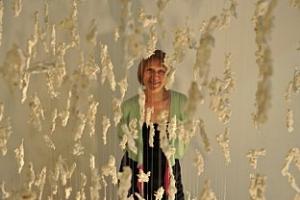Artist
My current work focuses on climate change, marine conservation and consumerism. I am also interested in how art can help to reach new audiences and build more understanding about our impact on the natural world and the environment.
I work with clay predominantly and am experimenting with print on clay, paper and glass. I make collections of work and installations.
The Empty Sea
Statistics about overfishing are alarming. Three-quarters of the world’s fish stocks are harvested faster than they can reproduce. Krill, the staple diet of marine species, is being fished aggressively to produce health supplements. 90% of all large predatory fish such as tuna, sharks, swordfish, cod and halibut are gone. Scientists predict that if current trends continue, world food fisheries could collapse by 2050.( Worm et al (2006), “Impact of biodiversity loss on ocean ecosystem services”, Science, 314 (5800), p.787).
This work uses clay and print to explore the narrative around over-fishing and marine conservation. Key pieces of work are:
Discarded (2014): Hundreds of rusty sardine cans (earthenware) on wires, hanging from steel hooks: a comment on the practice of discarding fish that have been caught over quota.
200 Years in the North Sea (2014): A timeline of scenarios inside fish kettles, charting the times of plenty and famine in the North Sea from the mid 19th century. It follows the history of whaling, the herring industry, the white fish industry and finally, North Sea Oil.
Making Waves (2014): A series of porcelain plates showing different scenarios from North East Scotland.
For the above work I am indebted to the Aberdeenshire Museums Service for allowing me to use imagery from their archives. I also gained a greater understanding of the issues from “Ocean of Life” by Callum Roberts, Penguin Books, 2013.
The Dying Sea
Climate change has had an enormous impact on the sea. The sea is sacrificing itself by absorbing half the carbon dioxide we have produced over the past 200 years. The result is that the temperature and acidity of the sea is increasing, attacking shellfish, plankton and coral, which are at the base of the marine food chain. Coral reefs are bleaching and dying at an alarming rate. Reefs are also injured by tourism and destructive fishing practices such as bottom trawling.
Some of this work is massed into collections and taxonomies as if on display in a museum. Other works are suspended as if floating in water. White clay emphasises the fragility of the skeletal bleached remains.
An international coral nursery project is having some success with breeding baby corals and regenerating reefs, but unless we can significantly reduce carbon emissions, future generations may only see dead corals in museums.
Dressed to Kill
This work is a response to reading the War on Want Report 2008 about the use of sweatshops and child labour in the fashion industry. Many families rely on the wages earned by child labourers, leaving the children unable to access education and get their family out of the cycle of poverty.
The work is also a comment on how consumers expect clothing to be cheap and not to last beyond a season. There is very little engagement with the method of production and the conditions which labourers endure.
Paper Prints
Please let me have your comments on my work and your views about any of the above here
